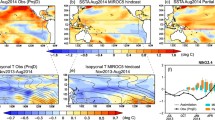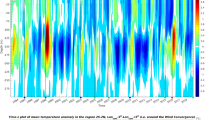Abstract
In this work, we examine the connection of vertical temperature gradient of the tropospheric atmosphere along the equator with El Niño–Southern Oscillation (ENSO) and the possible impact of the long-term change of the gradient. It is suggested that when the temperature anomalies in the lower troposphere are relatively warmer (cooler) than in the upper troposphere, the atmosphere is less (more) stable and favors an El Niño (a La Niña) event to develop. ENSO evolutions in 1997–1998 and 2014–2015 events are good examples of this relationship. They started from similar ocean anomaly states in the springs of 1997 and 2014, but developed into an extreme El Niño in 1997–1998 and a borderline El Niño in 2014–2015. That may be partially due to differences in the evolutions of the vertical temperature anomaly gradient in troposphere. Thus, in addition to the significant atmospheric response to ENSO, the preconditioning of vertical gradient of the tropospheric temperature due to internal atmospheric processes to some extent may play an active role in affecting ENSO evolution. The long-term trend with more pronounced warming in the upper troposphere than in the lower troposphere causes a reduction in the vertical temperature gradient in the troposphere. Moreover, unlike almost homogenous warm anomalies in the upper troposphere, the lower troposphere shows remarkable regional features along the equator during 1979–2014, with cold anomaly trends over the central and eastern Pacific Ocean associated with the so-called hiatus and some warm anomalies on its two sides in the east and west. This vertical and zonal distribution of the air temperature trends in the troposphere over the Pacific Ocean is consistent with the convection suppression over the central Pacific since 2000, implying a weakening of atmosphere and ocean coupling.












Similar content being viewed by others
References
An S-I, Choi J (2015) Why the twenty-first century tropical Pacific trend pattern cannot significantly influence ENSO amplitude? Clim Dyn 44(1–2):133–146
Barnston AG, Chelliah M, Goldenberg SB (1997) Documentation of a highly ENSO-related SST region in the equatorial Pacific. Atmos Ocean 35:367–383
Barnston AG, Tippett MK, L’Heureux ML, Li S, DeWitt DG (2012) Skill of real-time seasonal ENSO model predictions during 2002-2011—Is our capability increasing? Bull Am Meteor Soc 93(5):631–651
Bjerknes J (1969) Atmospheric teleconnections from the equatorial Pacific. Mon Wea Rev 97:163–172
Bretherton CS, Widmann M, Dymnikov VP, Wallace JM, Blade I (1999) Effective number of degrees of freedom of a spatial field. J Clim 12:1990–2009
Chiang JCH, Sobel AH (2002) Tropical tropospheric temperature variations caused by ENSO and their influence on the remote tropical climate. J Clim 15:2616–2631
Collimore C, Martin D, Hitchman M, Huesmann A, Waliser D (2003) On the relationship between the QBO and tropical deep convection. J Clim 16(15):2552–2568
Collins M et al (2011) The impact of global warming on the tropical Pacific Ocean and El Niño. Nat Geosci 3:391–397. doi:10.1038/ngeo868
Ding R, Li J, Tseng Y, Sun C, Guo Y (2015a) The Victoria mode in the North Pacific linking extratropical sea level pressure variations to ENSO. J Geophys Res Atmos 120(1):27–45
Ding R, Li J, Tseng Y, Ruan C (2015b) Influence of the North Pacific Victoria mode on the Pacific ITCZ summer precipitation. J Geophys Res Atmos 120(3):964–979
Fedorov AV, Philander SG (2000) Is El Niño changing? Science 288:1997–2002
Guan Y, Zhu J, Huang B, Hu Z-Z, Kinter JL (2014) Southern subtropical Pacific dipole: a predictable mode on multi-seasonal time scales. J Clim 27(4):1648–1658. doi:10.1175/JCLI-D-13-00293.1
Henley BJ, Gergis J, Karoly DJ, Power S, Kennedy J, Folland CK (2015) A tripole index for the interdecadal Pacific oscillation. Clim Dyn 45(11):3077–3090. doi:10.1007/s00382-015-2525-1
Hoerling M, Kumar A, Zhong M (1997) El Niño, La Niña, and the nonlinearity of their teleconnections. J Clim 10:1769–1786
Horii T, Ueki I, Hanawa K (2012) Breakdown of ENSO predictors in the 2000s: decadal changes of recharge/discharge-SST phase relation and atmospheric intraseasonal forcing. Geophys Res Lett 39:L10707. doi:10.1029/2012GL051740
Hu Z-Z, Kumar A, Jha B, Wang W, Huang Bohua, Huang Boyin (2012a) An analysis of warm pool and cold tongue El Niños: air–sea coupling processes, global influences, and recent trends. Clim Dyn 38(9–10):2017–2035. doi:10.1007/s00382-011-1224-9
Hu Z-Z, Kumar A, Jha B, Huang B (2012b) An analysis of forced and internal variability in a warmer climate in CCSM3. J Clim 25(7):2356–2373
Hu Z-Z, Huang B, Kinter JL III, Wu Z, Kumar A (2012c) Connection of stratospheric QBO with global atmospheric general circulation and tropical SST. Part II: interdecadal variations. Clim Dyn 38(1–2):25–43. doi:10.1007/s00382-011-1073-6
Hu Z-Z, Kumar A, Huang B, Wang W, Zhu J, Wen C (2013a) Prediction skill of monthly SST in the North Atlantic Ocean in NCEP Climate Forecast System version 2. Clim Dyn 40(11–12):2745–2756. doi:10.1007/s00382-012-1431-z
Hu Z-Z, Kumar A, Ren H-L, Wang H, L’Heureux M, Jin F-F (2013b) Weakened interannual variability in the tropical Pacific Ocean since 2000. J Clim 26(8):2601–2613. doi:10.1175/JCLI-D-12-00265.1
Hu Z-Z, Kumar A, Huang B, Zhu J, Guan Y (2014) Prediction skill of North Pacific variability in NCEP Climate Forecast System version 2: impact of ENSO and beyond. J Clim 27(11):4263–4272. doi:10.1175/JCLI-D-13-00633.1
Hu Z-Z, Kumar A, Huang B (2016) Spatial distribution and the interdecadal change of leading modes of heat budget of the mixed-layer in the tropical Pacific and the association with ENSO. Clim Dyn 46(5–6):1753–1768. doi:10.1007/s00382-015-2672-4
Huang B, Hu Z-Z, Kinter JL III, Wu Z, Kumar A (2012) Connection of stratospheric QBO with global atmospheric general circulation and tropical SST. Part I: methodology and composite life cycle. Clim Dyn 38(1–2):1–23. doi:10.1007/s00382-011-1250-7
IPCC (2013) Climate Change 2013: The Physical Science Basis. In: Stocker TF et al. (eds) Contribution of Working Group I to the Fifth Assessment Report of the Intergovernmental Panel on Climate Change. Cambridge University Press, Cambridge, United Kingdom and New York, NY, USA, 1535 pp
Jiang X, Yang S, Li J, Li Y, Hu H, Lian Y (2013) Variability of the Indian Ocean SST and its possible impact on summer western North Pacific anticyclone in the NCEP Climate Forecast System. Clim Dyn 41(7–8):2199–2212
Jin F-F, Hu Z-Z, Latif M, Bengtsson L, Roeckner E (2001) Dynamics and cloud-radiation feedbacks in El Niño and greenhouse warming. Geophys Res Lett 28(8):1539–1542
Kanamitsu M, Ebisuzaki W, Woollen J, Yang S-K, Hnilo JJ, Fiorino M, Potter GL (2002) NCEP-DOE AMIP-II Reanalysis (R-2). Bull Am Meteor Soc 83:1631–1643
Kumar A, Hoerling MP (2003) The nature and causes for the delayed atmospheric response to El Nino. J Clim 16:1391–1403
Kumar A, Hu Z-Z (2014) Interannual and interdecadal variability of ocean temperature along the equatorial Pacific in conjunction with ENSO. Clim Dyn 42(5–6):1243–1258. doi:10.1007/s00382-013-1721-0
Kumar A, Wang H, Xue Y, Wang W (2014a) How much of monthly subsurface temperature variability in the equatorial Pacific can be recovered by the specification of sea surface temperatures? J Clim 27:1559–1577. doi:10.1175/JCLI-D-13-00258.1
Kumar A, Jha B, Wang H (2014b) Attribution of SST variability in global oceans and the role of ENSO. Clim Dyn 43:209–220. doi:10.1007/s00382-013-1865-y
Kumar A, Chen M, Xue Y, Behringer D (2015) An analysis of the temporal evaluation of ENSO prediction skill in the context of equatorial Pacific ocean observing system. Mon Wea Rev 143:3204–3213
L’Heureux ML, Tippett MK, Barnston AG (2015) Characterizing ENSO coupled variability and its impact on North American seasonal precipitation and temperature. J Clim 28:4231–4245. doi:10.1175/JCLI-D-14-00508.1
Latif M, Keenlyside N (2008) El Niño/Southern Oscillation response to global warming. Proc Natl Acad Sci 106(49):20578–20583. doi:10.1073/pnas.0710860105
Liebmann B, Smith CA (1996) Description of a complete (interpolated) outgoing long wave radiation dataset. Bull Am Meteor Soc 77:1275–1277
McPhaden MJ (2012) A 21st century shift in the relationship between ENSO SST and warm water volume anomalies. Geophys Res Lett 39:L09706. doi:10.1029/2012GL051826
McPhaden MJ, Lee T, McClurg D (2011) El Niño and its relationship to changing background conditions in the tropical Pacific Ocean. Geophys Res Lett 38:L15709. doi:10.1029/2011GL048275
Meehl GA, Teng H, Branstator G (2006) Future changes of El Niño in two global coupled climate models. Clim Dyn 26(6):549. doi:10.1007/s00382-005-0098-0
National Research Council (2010) Assessment of intraseasonal to interannual climate prediction and predictability, 192 pp, ISBN-10: 0-309-15183-X, the National Academies Press, Washington, DC, USA
Nie J, Sobel AH (2015) Responses of tropical deep convection to the QBO: cloud-resolving simulations. J Atmos Sci 72(9):3625–3638
Pedhazur EJ (1997) Multiple regression in behavioural research: explanation and prediction, 3rd edn. Holt Rinchart & Winston, Austin
Rasmusson EM, Carpenter TH (1982) Variation in tropical sea surface temperature and surface wind fields associated with Southern Oscillation/El Niño. Mon Wea Rev 110:354–384
Reynolds RW, Rayner NA, Smith TM, Stokes DC, Wang W (2002) An improved in situ and satellite SST analysis for climate. J Clim 15:1609–1625
Saha S et al (2006) The NCEP climate forecast system. J Clim 19:3483–3517
Sobel AH, Held IM, Bretherton CS (2002) The ENSO signal in tropical tropospheric temperature. J Clim 15:2702–2706
Vecchi GA et al (2006) Weakening of tropical Pacific atmospheric circulation due to anthropogenic forcing. Nature 441:73–76
Wang B, An S-I (2002) A mechanism for decadal changes of ENSO behavior: roles of background wind changes. Clim Dyn 18:475–486
Wang W, Chen M, Kumar A (2010) An assessment of the CFS real-time seasonal forecasts. Wea Forecast 25:950–969. doi:10.1175/2010WAF2222345.1
Xiang B, Wang B, Li T (2013) A new paradigm for the predominance of standing Central Pacific warming after the late 1990s. Clim Dyn 41(2):327–340. doi:10.1007/s00382-012-1427-8
Yeh S-W, Kirtman BP, Kug J-S, Park W, Latif M (2011) Natural variability of the central Pacific El Niño event on multi-centennial timescales. Geophys Res Lett 38:L02704. doi:10.1029/2010GL045886
Zhu J, Kumar A, Huang B, Balmaseda MA, Hu Z-Z, Marx L, Kinter JL III (2016) The role of off-equatorial surface temperature anomalies in the 2014 El Niño prediction. Sci. Rep. 6:19677. doi:10.1038/srep19677
Acknowledgements
We appreciate the insight comments and constructive suggestions from Dr. Ji Nie and another two reviewers as well as Dr. Peitao Peng. Bohua Huang is supported by grants from NSF (AGS-1338427), NOAA (NA14OAR4310160), and NASA (NNX14AM19G). The scientific results and conclusions, as well as any view or opinions expressed herein, are those of the author(s) and do not necessarily reflect the views of NWS, NOAA, or the Department of Commerce. All the data used in this work are available at NCEP/CPC.
Author information
Authors and Affiliations
Corresponding author
Rights and permissions
About this article
Cite this article
Hu, ZZ., Huang, B., Tseng, Yh. et al. Does vertical temperature gradient of the atmosphere matter for El Niño development?. Clim Dyn 48, 1413–1429 (2017). https://doi.org/10.1007/s00382-016-3149-9
Received:
Accepted:
Published:
Issue Date:
DOI: https://doi.org/10.1007/s00382-016-3149-9




